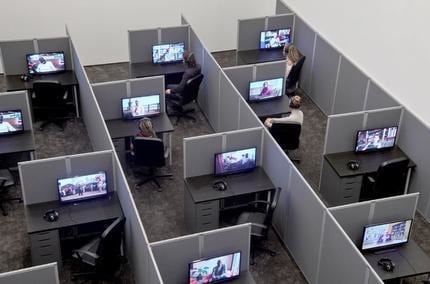
Kader Attia's, "Reason's Oxymorons"
by Osman Yerebakan
Kader Attia’s recurring themes, such as repair, trauma, and loss, occupy Lehmann Maupin’s Lower East Side location in his ambitious exhibition Reason’s Oxymorons. The modular cubicle installation, which had its debut at the 13th Biennale de Lyon in 2015, immerses the audience in a multifaceted survey of psychiatric practices developed to treat traumatic experiences. Roaming through a labyrinthine structure reminiscent of generic office architecture, participants encounter eighteen video interviews, discussing concepts from “Genocide” to “Trance,” “Religion,” “Exile,” “Illness,” and “Modernity.” Conducted with European and African practitioners, the interviews deliver commentaries on methodologies of psychotherapy practiced in disparate parts of the globe. The interviewees, including philosophers, healers, historians, psychoanalysts, and patients, promptly address the camera to answer questions about mental and psychical restoration, stoic amidst their personal habitats—ranging from a professor’s book-filled apartment to a doctor’s office.
Attia, whose multimedia body of work centers an ongoing investigation of the cultural, political, and social transformations non-Western cultures face under the impact of colonialism, has long been interested in psychical and mental repair. The Paris-born Algerian artist has, for example, transformed prosthetic limbs into sculptural arrangements to juxtapose the agony of loss with the process of reconciliation. In his current installation, Attia examines different approaches to repair practiced within Western and non-Western societies. “[The] Western mind is about going back to the original and repairing, as opposed to traditional societies,” states the artist, recalling the Japanese kintsugi tradition of filling the cracks in pottery with lacquer mixed with powdered gold or silver. Placing his viewers within a corporate and inhospitable environment, the artist asks for commitment to each video’s firsthand and exceptional perspective on the human condition. The maze of cubicles subjugates the viewer, requiring them to maneuver around the partitions. In this way, Attia turns his audience into a political body exposed to mental and psychological examination in an official ambiance in which they feel monitored and subdued through the uncanny familiarity of the claustrophobic environment.
The artist’s upbringing in both Algeria and the suburbs of Paris broadens his perspective in observing and studying the handling of physical and mental trauma in African and European cultures. Attia reaches the oxymoron in the concept of “repair”: while the futility of going back to the original complicates the possibility of complete reconciliation, the Western mind challenges any imperfection, seeking to fix visible “defects.” From hospitalization of those deemed mentally insane to plastic surgeries promoted to correct imperfections, Western practices resist the progression of the imperfect. In his 1961 book Madness and Civilization, Michel Foucault discusses the oppression of those considered mad and counterproductive by authorities, with the emergence of the Enlightenment and later Industrial Revolution. One of the interviewees in Attia’s Art As Therapy: Part 1, (an earlier work, not on display in the current show) conversely discusses how certain societies embrace people with mental disorders and how such individuals positively integrate into their communities.
The modern Western approach to death suggests the restraint of bereavement, appointing secluded methods for coping with the consequent melancholy. The burden of disenfranchised grief, therefore, suggests contemplation of loss through materialist reasoning and introspective rumination for the former. The recent recipient of the Prix Marcel Duchamp, Attia grasps such dichotomies through diligent research and engagement, investigating and contextualizing nuances that constitute our existence and urge for survival.
